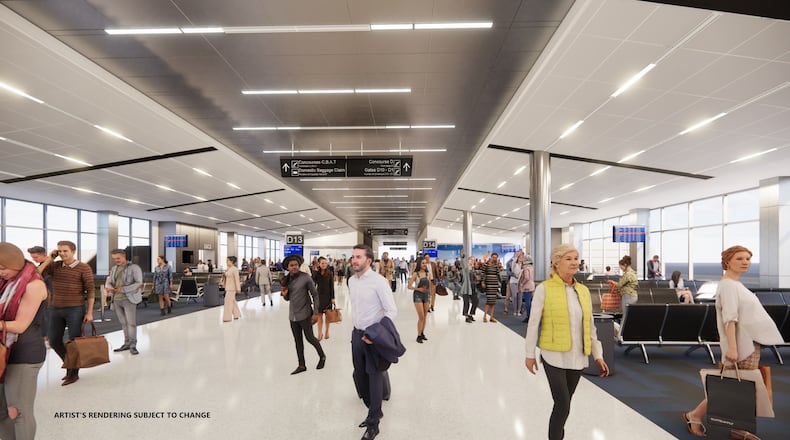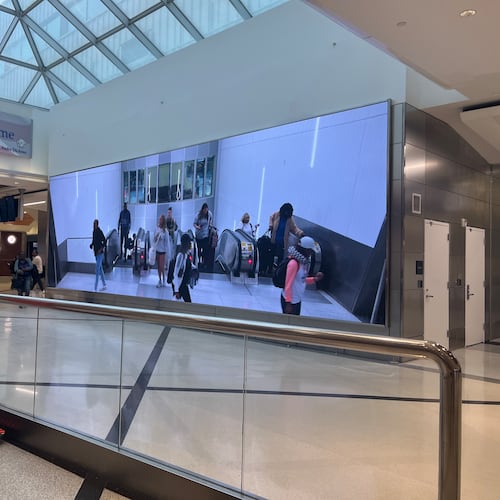Hartsfield-Jackson International Airport plans to use a novel approach to widen a working concourse: Pre-fabricated construction.
New pieces of the structure will essentially be built about a mile away, brought to the existing concourse structure and and connected like toy building bricks.
The airport is embarking on one of its most complex construction projects, a $1.4 billion plan to widen Concourse D while passengers continue to pass through and planes pull in and out. Airport officials plan to seek Atlanta City Council approval for the next phase of work that will cost about $200 million, following $165 million of work already approved.
The project will mean detours and construction zones in the airport’s narrowest concourse, causing upheaval for passengers, airlines and concessionaires. And it’s expected to take until summer 2029 to complete.
The airport’s ongoing construction around the airport, in parking decks and the Plane Train tunnel, have already caused maddening frustration for travelers for years. The Concourse D work will be another phase of the airport’s nearly $12 billion in expansion plans.
“There’s gonna be some disruption,” warned Hartsfield-Jackson General Manager Balram Bheodari.
Concourse D is already so cramped that during busy periods, passengers must dodge their way through the crowds and boarding queues that spill out into the walkway. The concourse’s capacity is more than 37,000 passengers a day.
“It is really a tight squeeze,” said Frank Rucker, deputy general manager of infrastructure at Hartsfield-Jackson. That’s what’s motivating the widening. Atlanta-based Delta Air Lines is the dominant airline on Concourse D, while Spirit, Frontier and JetBlue also use gates there.
To minimize disruption to travelers from construction, airport officials plan to have giant sections of the concourse additions constructed south of the concourse at a site on the south side of the airport’s property. When each piece is completed, it will be transported to Concourse D and attached to the building. Rucker called it “a viable solution to the problem.”
Construction of the first pre-fabricated steel module will begin late this year. The new concourse ceiling will be 18-feet high. The longest pieces will be 30-feet deep and up to 192-feet-long. Imagine a block of steel nearly the length of an ice hockey rink with cladding attached, transported with high-tech equipment across a portion of the airfield at night.
This will be the first time this approach has been used by the airport, Rucker said, and the first time an airport has attempted a concourse widening of this type.
Hartsfield-Jackson officials now plan to add sections to the 60-foot-wide concourse to make it 99-feet wide.
Credit: Source: Hartsfield-Jackson
Credit: Source: Hartsfield-Jackson
That marks a shift from earlier plans to build a 102-foot-wide concourse to be completed in 2028. Airport officials decided to reduce the dimensions slightly to “deliver the best value for the project,” according to a spokesman. Timing to start construction was delayed due to pre-construction work based on input from joint venture Holder-Moody-Bryson-Sovereign, the contractor brought on last year for the project.
The new concourse will have higher ceilings and 14-foot-tall windows — like other renovated concourses at the airport — with plans for “smart” windows with self-tinting properties on the widened Concourse D. As frames for the building are installed and built, the existing walls and roof will be demolished. The concourse will also now be extended by about 288 feet.
Airport officials had earlier considered tearing down the existing concourse entirely and then rebuilding it, but “this is a more efficient and more economical option,” Bheodari said.
Credit: Source: Hartsfield-Jackson
Credit: Source: Hartsfield-Jackson
The project last year received $40 million in federal funding from the bipartisan infrastructure law, and will also be funded with airport bonds and passenger facility charges, which are the $4.50 fee per flight segment paid by airline passengers.
Two gates are already closed for utility work in preparation for construction.
Starting in January 2024, up to eight gates on Concourse D will close at a time — and travelers will be directed through a corridor down the concourse alongside sections of the concourse that are blocked off.
Signs will “direct people through a construction zone, which is a big deal,” Rucker said. “The main corridor will be relocated in several phases... You’ll play hopscotch, so to speak.”
As part of the project, the airport plans to mitigate the loss of gates by constructing three new gates on international Concourse E. The airport last year completed an addition of five gates on Concourse T. The Concourse E extension work will start this July and be complete by December 2024.
Even when the widening is complete, Concourse D will actually end up with fewer gates. While there are currently 40 gates on Concourse D, the new widened version will have just 34 gates.
Credit: Source: Hartsfield-Jackson
Credit: Source: Hartsfield-Jackson
That’s because the project is aimed at accommodating larger jets, which also need more space to park.
Ultimately, the 34 gates will have capacity to handle more passengers than the 40 gates do today, according to the airport.
Airport officials say they downsized the number of gates planned for the concourse principally because of changes in the fleet of planes used by Delta. Delta and other major carriers are retiring many of their small regional jets and shifting to larger airplanes. Delta Connection plans to stop flying 50-seat regional jets as of this summer.
Instead, airlines are flying larger planes that carry more passengers than can comfortably fit in Concourse D’s smaller gate areas. The concourse was one of the domestic terminal’s five original concourses designed and built in the 1970s, for airlines that had limited operations in Atlanta.
Airlines are shifting to 70-seat regional jets and mainline jets with 110 seats or more. “Ultimately with bigger airplanes, you just need more floor area,” said Tom Nissalke, assistant general manager of planning and development at Hartsfield-Jackson. Most of the new gates will still be able to also accommodate regional jets, he said.
The aim is to improve the traveler experience in future decades, but it will cause headaches over the next five years. Airport officials said they will have a plan to direct customers and handle congestion.
“We’re an airport first, construction site second,” Nissalke said.
Credit: Source: Hartsfield-Jackson
Credit: Source: Hartsfield-Jackson
About the Author
The Latest
Featured






